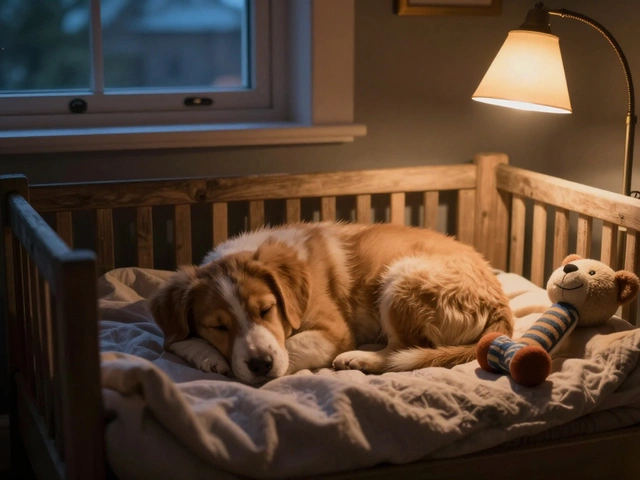
So, you're on the hunt for a new dog bed, but you're stuck wondering if bigger is really better. It seems simple until you start thinking about your dog's comfort, support, and security. Too small, and your pup might feel cramped. Too big, and it could feel like sleeping in an open field. So, how do you strike the right balance?
First things first, consider your dog's size and sleeping style. Just like us, every dog has its own way of getting comfy. Does your pup curl up in a tight ball, or does it sprawl out? Knowing this can really help when picking a bed.
A bigger bed isn't just about space. It's about giving your furry friend room to stretch, twist, and turn to find that perfect spot. But, bigger doesn’t always guarantee comfort. Some dogs like to feel tucked in, so finding the right fit is key. Let's explore the ins and outs of choosing the perfect bed size for your pooch.
- Understanding Your Dog's Size and Sleep Style
- Benefits of a Bigger Dog Bed
- Potential Downsides to Oversized Beds
- Choosing the Perfect Bed Size
- Tips for Maintaining Your Dog's Bed
Understanding Your Dog's Size and Sleep Style
Getting to know your dog's size and preferred sleep style is crucial when picking the perfect dog beds. Just like humans, dogs have their own sleep habits that should be considered. A closer look can go a long way in ensuring your pup's comfort.
So, what's your dog's go-to sleep position? Does your pup curl up like a donut or take up an entire couch? Dogs that curl up might do well with a smaller, cozier bed that offers them a sense of security. On the flip side, dogs that love stretching out will appreciate a bed with more room to sprawl.
Check Your Dog's Actual Measurements
It's all good thinking about sleep styles, but you also need to know your dog's real size. Measure your dog from nose to tail and from shoulder to paw when they stand and when they lie down. This will give you a better idea of the minimum bed dimensions you'll need.
- Length: The dog's full body length in its sleeping position.
- Space: Add a few inches to make sure they have enough room to move around.
Understanding Dog Breeds and Bed Needs
Certain breeds have common traits when it comes to sleep. Breeds like Greyhounds or Whippets, that are notoriously known for lounging, might need something much different than smaller breeds like Dachshunds or Terriers. Size, age, and even health conditions, like arthritis, can play a role too.
Interestingly, studies show many dogs sleep for about 12 to 14 hours a day depending on age. Young puppies and older dogs tend to spend more time napping. This highlights just how important a good sleeping space is for your furry friend!
Ultimately, understanding your dog's size and sleep style will guide you to choose a dog bed size that hits the sweet spot between snug and spacious. Keep these tips handy next time you're shopping, and your dog will thank you with wagging tails and blissful sleep.
Benefits of a Bigger Dog Bed
When it comes to dog beds, it might seem like the more space, the better. But what exactly makes a bigger bed beneficial for your furry friend? Let's dig into it.
Room to Stretch and Move
One of the biggest perks of a large bed is the room it provides. Whether your pup likes to curl up into a ball or stretch out like a starfish, a bigger dog bed gives them the space they need. This freedom to move without falling off can make naptime more restful and is especially handy for larger breeds.
Flexibility for Different Sleep Styles
Even if your pup is small, dogs don't necessarily sleep in the same position all night. A large bed accommodates those overnight shifts from a curled up pose to a full sprawl. Your dog stays comfortable, uninterrupted by the edge of the bed.
Added Comfort for Multiple Dogs
If you have more than one dog or your pup loves sharing with the family cat, a larger bed offers room for cuddling. This can boost their sense of companionship and warmth during sleep.
Aging or Arthritic Dogs
For older dogs or those with joint issues, a bigger dog bed often has extra padding and space, making it easier for them to find a comfortable sleeping position. It reduces pressure on aching joints and gives them a cozy spot to rest those aging bones.
Statistical Insight
According to recent pet surveys, owners report a 25% increase in overall satisfaction levels regarding their pet's comfort after switching to a larger bed.
Of course, while there are great benefits to having a bigger bed, it's essential to consider your dog's preferences and habits before making a choice. Not all dogs will appreciate the extra space, while some will never want to leave it. Tailoring the bed size to include these preferences ensures they get the best sleep possible.

Potential Downsides to Oversized Beds
At first glance, a massive dog bed may seem like a luxury for your pet, offering them sprawling space to move around. But bigger isn't always better, and there are several reasons why an oversized bed might not be the ideal choice.
Space Efficiency
Big dog beds take up a lot of room in your home. If you live in a cozier space, that might mean sacrificing valuable floor space. You don't want to be tripping over a bed that's bigger than your coffee table.
Security Concerns
Dogs often seek comfort in enclosed spaces. An oversized bed can make them feel exposed, rather than secure like a smaller, snug space might. Some dogs prefer the feeling of walls touching them as they sleep—this is similar to how we enjoy a warm, enveloping blanket.
Lack of Support
Too much room in a bed may mean less support for your dog's joints and muscles. Your dog may end up in awkward positions without the necessary support they would get from a properly-sized bed.
Cost and Maintenance
Larger dog beds usually come with a heftier price tag and require more cleaning effort. More fabric means more dirt and hair, which isn't fun when it comes to maintenance. Plus, replacing them due to wear and tear can add up.
Temperature Regulation
A small bed helps retain your dog's body heat, keeping them warm and cozy. Oversized beds can result in heat loss, making it difficult for some dogs, especially smaller breeds or those with thin fur, to stay warm.
| Aspect | Issue |
|---|---|
| Space | Consumes too much room |
| Cost | Higher purchase and maintenance cost |
| Heat Retention | May lose heat, keeping the dog cold |
While having a larger dog bed seems like an inviting option, it's essential to weigh the pros and cons. Consider what would genuinely make your dog feel both comfortable and secure in your shared space.
Choosing the Perfect Bed Size
Picking the right dog bed size isn't just about eyeballing it and hoping for the best. There's a bit of science and understanding needed to make sure your pup dreams sweetly.
Measure Your Dog Correctly
Start with measuring your dog. From the tip of the nose to the tail base and then across the widest part (usually the shoulders). Add about 6 to 12 inches to these measurements. This gives your dog enough room to stretch without feeling limited.
Factor in Sleep Position
If your dog likes to sprawl, lean towards the higher end of the added inches. For curlers, a smaller space can feel more snug. This simple trick helps in choosing the right dog bed size.
Pick the Right Bed Shape
The bed's shape can make a difference. There are oval, circular, and rectangular beds. For dogs that curl up, circular beds might be ideal. Sprawlers could be more comfortable in rectangular beds.
"Comfort is essential for chronic pain management in pets," says Dr. Sarah Wilcox, author of 'Your Dog's Best Sleep'.
Material Matters
Don't overlook bed materials. Memory foam beds provide superior joint support, perfect for older dogs. Washable covers are a lifesaver to keep it clean and fresh.
Trial and Error
Sometimes, the best way to choose is to test it out. Many retailers offer trial periods, so take advantage of that to ensure the bed meets your dog's needs.
A good quality dog bed can last years, making it worth the investment. Consider these factors, and you're likely to make a choice that keeps tails wagging and dreams sweet.

Tips for Maintaining Your Dog's Bed
Keeping your furry friend's bed in tip-top shape is not all that complicated. Regular maintenance ensures your pet's bed stays cozy, clean, and inviting. Plus, it helps the bed last longer, saving you some bucks in the long run. So, what are some effective ways to maintain a dog bed?
Regular Washing
Most dog beds come with removable covers that are machine washable. Wash these at least once a month, or more frequently if your dog sheds a lot or plays outside often. Use a pet-safe detergent and keep the water temperature below 140°F to prevent material shrinkage.
Vacuum Weekly
To tackle hair, dirt, and dander, give the bed a good vacuum once a week. This keeps allergens in check and the bed looking fresh. Use a vacuum attachment specifically for upholstery to get into nooks and crannies.
Spot Clean as Needed
Accidents happen, right? If your pup has a little mishap, use a mixture of vinegar and water to spot clean. Blot the area instead of rubbing it to avoid damaging the fabric.
Rotate and Fluff
Just like with your own mattress, rotating your dog's bed regularly can help maintain its shape. Give it a good fluffing to redistribute any filling that's bunched up. Your pooch will thank you!
Waterproof Liners
Invest in a waterproof liner if you're worried about spills or accidents. They fit between the bed and the cover, keeping the insides dry and odor-free.
| Washing Frequency | Vacuum Frequency |
|---|---|
| Monthly | Weekly |





